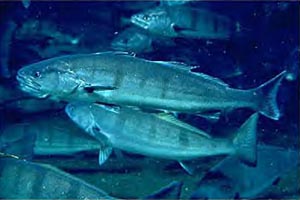Executive Summary

White seabass are large, highly prized members of the croaker family, found in waters off the west coasts of California and Mexico. White seabass are recovering off California from low population levels in the mid to late 1900s. The current recovery is occurring under management designed to provide for moderate harvests while protecting young white seabass and spawning adults through seasonal closures, gear provisions, and size and bag limits.
Concern over the decline in white seabass landings and conflict between recreational and commercial fishermen over this resource resulted in legislation requiring the development of a white seabass fisheries management plan (WSFMP). The plan was developed in 1995 through the cooperative efforts of academic and federal fishery scientists, consultants, and fishery constituents. The plan was adopted by the Fish and Game Commission (Commission) in 1996; however, regulations to implement the WSFMP were not adopted at that time.
California enacted the Marine Life Management Act (MLMA) in 1998, granting broader regulatory authority to the Commission for specified commercial fisheries, including white seabass. The MLMA declared that the WSFMP shall remain in effect until amended, but it must be brought into conformance with the MLMA on or before 01 January 2002. This deadline was later extended in order to incorporate the recommendations of the peer review panel.
The MLMA further directs that all fisheries be managed on a sustainable basis using fishery management plans (FMPs). The MLMA specifies the content of FMPs, encourages management to use the best available information, supports research to obtain essential fisheries information, and promotes cooperation and collaboration with fisheries participants and other constituents. This document amends the WSFMP to reflect these goals and others of the MLMA and to otherwise achieve conformance with the MLMA.
The WSFMP uses a framework plan approach for managing the white seabass fishery. This enables the adjustment of management measures, within the scope and criteria established by this WSFMP and implementing regulations, without the need for amending the FMP. Framework adjustments can be implemented quickly, enabling more responsive adaptive management of white seabass. In addition to annual management changes, the Commission may make in-season adjustments to address resource conservation or socioeconomic issues. A Department white seabass management team along with an advisory panel consisting of representatives from the scientific community, recreational and commercial fishing industries, and environmental groups will continually monitor the effectiveness of management measures, and recommend changes to the Commission if needed.
In addition to the framework procedures, initial management alternatives are proposed for implementation upon approval of the WSFMP. These alternatives represent different determinations of a maximum sustainable yield (MSY) and optimum yield (OY) to be used in setting upper harvest limits for white seabass. The OYs range from 212,985 pounds to 1.3 million pounds. The preferred alternative is an OY of 1.2 million pounds. This OY was derived by making a precautionary adjustment to an MSY proxy that was calculated from a previously determined pre-exploitation biomass of white seabass.
The preferred alternative, along with a framework plan approach, will allow continued recovery of the white seabass resource while important data are collected to yield a better defined MSY/OY control rule. The WSFMP also includes several trigger mechanisms aimed at identifying and minimizing overfishing of the white seabass stock. Socioeconomic and bycatch impacts are not expected to be significant under the preferred alternative.
The WSFMP identifies specific short-term operational and long-term strategic research goals as part of research protocols that address needed essential fisheries information for white seabass. The overall goal is to bring our knowledge of white seabass stocks up from data-poor to data-rich; data-poor management of white seabass using an MSY/OY approach should be considered an interim solution. A stock assessment for white seabass using existing and ongoing datasets, along with new fishery independent information, is of paramount importance for the successful management of white seabass. Other short-term research goals include determinations of the size at sexual maturity, hooking mortality of released fish, amount of bycatch, and validation of age/growth studies.
Long-term research goals include development of more sophisticated stock assessments and models, expansion of hatchery-reared white seabass studies, collection and analyses of more socioeconomic data, cooperative research with Mexico and implementation of an ecosystem-based management approach.
The costs of implementing the WSFMP are estimated to be high. Most of the costs are associated with ongoing and future research (data collection and analysis), enforcement of regulations, and document preparation and review; the costs of research alone are estimated to be over $700,000 annually.
Content
 Final White Seabass Fishery Management Plan (PDF)
Final White Seabass Fishery Management Plan (PDF)
Annual Review Reports for the Fish and Game Commission
Each year the White Seabass Scientific and Constituent Advisory Panel meets to consider if current management measures are providing adequate protection for the white seabass resource. Annual reviews are conducted so that any changes in management, or to the White Seabass Fishery Management Plan, can be considered by the Commission in accordance with the requirements of the Marine Life Management Act. The Advisory Panel meets with CDFW each spring. The reports listed below reveal the findings from each review.